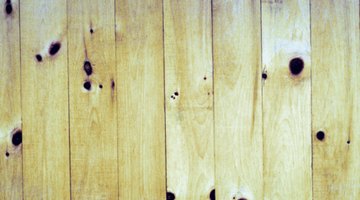How to Distress Pine
Distressing is the process of making wood appear older. This gives wooden furniture or decor a rustic, worn appearance that is synonymous with Old World charm and country living. When you distress wood, you intentionally damage it. Pine, a soft wood that is easily damaged, is an excellent candidate for distressing.

Things You Will Need
- Sandpaper
- Hammer
- Wood file
- Wire brush
- Plank
- Nails
- Rubber gloves
- Liquid drain cleaner
- Water
- Glass jar
- Cloths
- Wood stain
- Paint brush
The damage is always subtle and meant to mimic the effects of years of regular use or exposure to the elements. Distressing your unfinished pine furniture or other wooden home decor items will lend a sense of history to the wood.
-
Sand the pine in the direction of the grain of the wood. Use sandpaper with a fine grit to achieve a smooth finish.
-
Strike the pine surface lightly with the hammer to create a random pattern of dents. Vary the force of the hammering so the depth of the dents is not uniform.
-
File the edges of the wood. Make sure no sharp edges remain. File in the direction of the grain of the pine. Pine is a relatively soft wood that can easily be filed away, so take care to remove only as much wood as creates the appearance of natural wear. Edges and corners should be gently rounded when this step is complete.
-
Sand the filed edges of the wood to remove any splinters. Use a variety of sandpaper grit sizes to change the texture and produce natural smoothing over the edges or corners. The lower the grit number, the rougher the sandpaper. Rough sandpaper removes material more quickly than smooth paper and leaves a more rugged finish.
-
Drag the wire brush across the surface of the pine. Keep the strokes light and vary the direction and length of each stroke to produce the appearance of natural scratches.
-
Drive 7 to 10 nails of the same length into the plank. Leave at least one-third of the length of the nail protruding from the wood. (Althouigh the nails should be the same length, they can have different head sizes.) Space the nails at irregular distances so their heads do not create a regular pattern. Strike the pine surface lightly with the nail heads in the plank. The nail heads will produce small indentations, giving the wood a battered appearance.
-
Mix equal parts of liquid drain cleaner and water in the jar. Don rubber gloves. Dip a rag into the mixture and wipe it across the surface of the pine. Let the pine surface dry overnight. This aging solution will prevent uneven color distribution during staining.
-
Paint the pine with wood stain. Follow the stain manufacturer's instructions. Wipe away any excess stain with a clean cloth. Distressed areas will appear darker than the surrounding areas once the stain dries.
References
Writer Bio
Pearl Lewis has authored scientific papers for journals such as "Physica Status Solidi," "Materials Science and Engineering" and "Thin Solid Films" since 1994. She also writes an education blog entitled Simple Science in Everyday Life. She holds a doctorate from University of Port Elizabeth.
Photo Credits
- NA/AbleStock.com/Getty Images
- NA/AbleStock.com/Getty Images
More Articles



